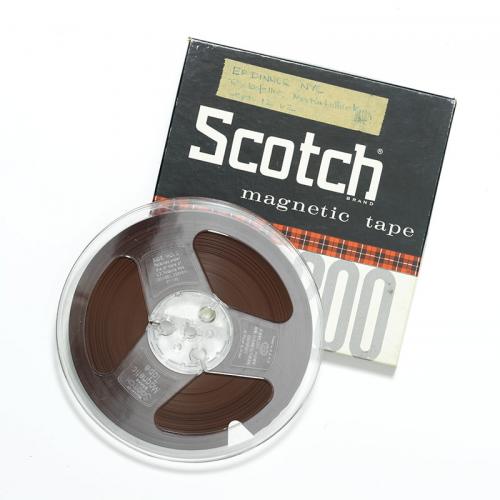
Audio Tape Reel containing the recording of Martin Luther King Jr.'s 1962 Address to the New York Civil War Centennial Commission. (New York State Museum History Collections)
Martin Luther King, Jr.'s 1962 Address to the New York Civil War Centennial Commission was recorded using reel-to-reel magnetic tape that allowed for 65 minutes of recording time per side at a recording speed of 7.5 ips (inches per second). Although Dr. King only spoke for 26 minutes, his speech had been preceeded by several others and only 15 minutes remained on the first side of the reel when he took to the podium.
The missing audio marks the moment when the tape ran out and the recording technician, Enoch Squires, had to manually flip each reel over, re-thread the tape through the tape head assembly and onto the takeup reel, and then restart the recording. Almost an entire minute of Dr. King's recorded speech was lost.
Reel-to-reel tape recording is a form of magnetic tape audio recording in which the recording medium is held on an open reel, threaded and fed through mechanical guides and a tape head assembly, and then transferred onto a second, initially empty, takeup reel. As the magnetic tape passes over the electromagnetic recording head, fluctuations in the magnetic field caused by electric impulses picked up from microphones or instruments, are transferred to tape.
Magnetic tape recording technology emerged in the 1930s, and it was the industry standard for audio recording and playback through the 1970s. While professional recording studios continued to use high-speed reel-to-reel recorders until the late 1980s, consumers were quick to switch to the smaller, light-weight cassette recorder by the 1970s. However, with the introduction of digital recording media, such as the compact disc, in 1982, the use of analog tape, whether reel-to-reel or cassette, declined significantly in the 1990s and has now become all but obsolete.
This Concorde Stereophonic 440 recording machine was considered to be a mid-range portable recording device and is probably similar to what Enoch Squires would have used when recording audio in remote locations. The New York State Museum maintains several reel-to-reel machines in its collections in order to preserve past technologies and, more significantly, to employ in the playback of donated audio reels that otherwise would be inaccessible.
Enoch Squires was born on March 24th, 1909 at Diamond Point in Lake George, New York. He began his career in radio in 1929 as a radio columnist for the Buffalo Evening News, and worked for several stations across the United States before being hired by WGY in 1953. There, he was best known for his work as the “Schenectady Traveler,” logging over 3,000 miles each month to gather the audio footage for the weekday show.
The New York State Museum’s collection contains nearly 400 reel-to-reel audio recordings of the “Schenectady Traveler,” donated to the museum in 1979 by Squires’ widow. Squires left WGY in 1961 to work as a research associate for the New York State Civil War Centennial Commission. It was in this capacity that he made the recording of the September 12, 1962 Commemoration Dinner, including Dr. Martin Luther King, Jr.’s address.